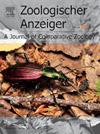巴西亚马逊热带雨林细翅蝗属两新种(直翅目:细翅蝗科:细翅蝗科)及其潜在分布模式的启示
IF 1.5
3区 生物学
Q2 ZOOLOGY
引用次数: 0
摘要
Leptopsis (Leptopsis)是南美洲的一个属,有两个亚属和七个有效种:Leptopsis (Leptopsis) Desutter-Grandcolas, 1996,包括Leptopsis (Leptopsis) nauta Desutter-Grandcolas, 1992, Leptopsis (Leptopsis) zumun Desutter-Grandcolas, 1992, Leptopsis (Leptopsis) saussurei Desutter-Grandcolas, ecuadori Gorochov, 2006,和Leptopsis (Leptopsis) ucayali Gorochov, 2011;和Leptopsis (Aberracla) Gorochov, 2011,包括Leptopsis (Aberracla) chopardi Desutter-Grandcolas, 1992和Leptopsis (Aberracla) morona Gorochov, 2011。本文描述了在巴西par本文章由计算机程序翻译,如有差异,请以英文原文为准。
Two new species of Leptopsis Desutter-Grandcolas, 1996 (Orthoptera: Phalangopsidae: Phalangopsinae) from the Brazilian Amazon rainforest with insights from potential distribution models for the genus
Leptopis is a South-American genus with two subgenera and seven valid species: Leptopsis (Leptopsis) Desutter-Grandcolas, 1996, including Leptopsis (Leptopsis) nauta Desutter-Grandcolas, 1992, Leptopsis (Leptopsis) zumun Desutter-Grandcolas, 1992, Leptopsis (Leptopsis) saussurei Desutter-Grandcolas, 1992, Leptopsis (Leptopsis) ecuadori Gorochov, 2006, and Leptopsis (Leptopsis) ucayali Gorochov, 2011; and Leptopsis (Aberracla) Gorochov, 2011, including Leptopsis (Aberracla) chopardi Desutter-Grandcolas, 1992, and Leptopsis (Aberracla) morona Gorochov, 2011. In this work, we describe two new species, Leptopsis (Leptopsis) vader sp. nov. and Leptopsis (Leptopsis) silens sp. nov, recorded in the state of Pará, Brazil, the first record of the genus in the country, and predict and discuss the distribution of the genus through Species Distribution Models (SDMs). These two new species are easily distinguished from the others by the shape of the phallic complex sclerites, specifically the pseudepiphallic sclerite A. Additionally, the females exhibit differences in copulatory papillae among species for which these structures are known. We also propose synonymizing Mellomima Desutter-Grandcolas, 2020 under Leptopsis (Aberracla), lowering the rank from genus to subgenus, and moving Mellomima guyanensis Desutter-Grandcolas, 2020 to the subgenus Leptopsis (Aberracla), under the combination Leptopsis (Aberracla) guyanensis comb. nov. The SDMs for the genus Leptopsis showed a reasonable fit despite the genus's current limited distribution. The model indicated a wide distribution across central and northern Amazonia, with the greatest coverage in the eastern region. High-suitability areas were also identified in countries where the genus has not yet been recorded, such as Venezuela, Guyana, and Suriname. Furthermore, the model predicted high-suitability regions outside Amazonian domains, particularly in northern Colombia and Venezuela. The bioclimatic variables that contributed most to the models and probably influence the genus distribution were the precipitation of the wettest quarter and isothermality.
求助全文
通过发布文献求助,成功后即可免费获取论文全文。
去求助
来源期刊

Zoologischer Anzeiger
生物-动物学
CiteScore
2.80
自引率
7.10%
发文量
75
审稿时长
>12 weeks
期刊介绍:
Zoologischer Anzeiger - A Journal of Comparative Zoology is devoted to comparative zoology with a special emphasis on morphology, systematics, biogeography, and evolutionary biology targeting all metazoans, both modern and extinct. We also consider taxonomic submissions addressing a broader systematic and/or evolutionary context. The overall aim of the journal is to contribute to our understanding of the organismic world from an evolutionary perspective.
The journal Zoologischer Anzeiger invites suggestions for special issues. Interested parties may contact one of the editors.
 求助内容:
求助内容: 应助结果提醒方式:
应助结果提醒方式:


